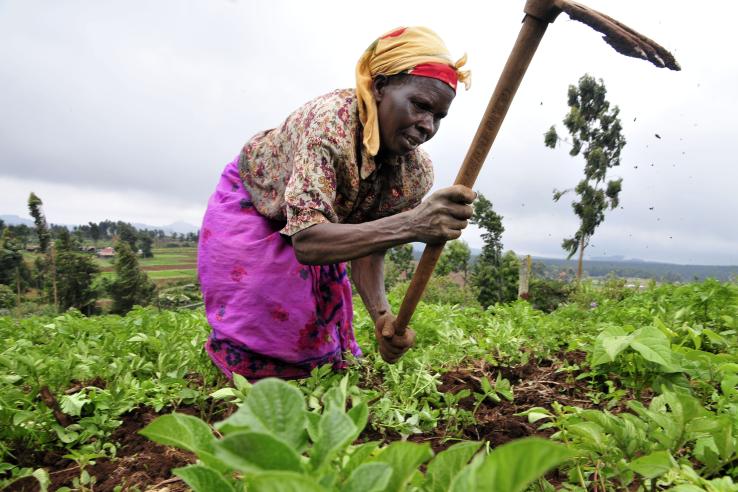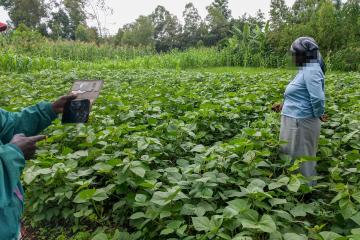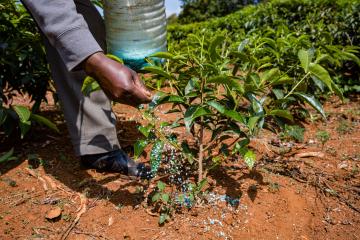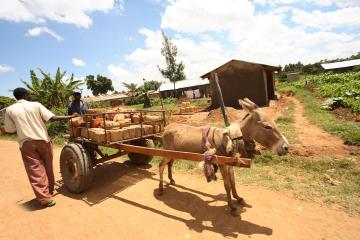Agricultural productivity and labor: Evidence and open questions for researchers

As farms become more productive, grow in size, or diversify into more lucrative crops, farmers require more labor hours and, often, more skilled labor. Labor needs may change with agricultural production practices, as commercial crops often require more labor than staples (e.g., horticulture requires additional weeding and regular harvesting in comparison to seasonal staple cultivation) and as farming practices change (e.g., regular irrigation requires consistent labor, and mechanization may displace labor at some stages of production). Despite being crucial to profitable farming systems, we know less about land and labor market failures than other constraints to agricultural technology adoption and productivity. Further evidence is required to understand important gaps in our knowledge of how farmers can best utilize household and hired labor, in addition to agricultural technologies.
Evidence from randomized evaluations on labor and agricultural productivity
The Agricultural Technology Adoption Initiative (ATAI), a collaboration between J-PAL and the Center for Effective Global Action (CEGA), was launched in 2009 to rigorously test programs that aim to increase farmers’ welfare through the broader use of technologies that help increase agricultural productivity in sub-Saharan Africa and South Asia. Since then, ATAI has funded randomized evaluations to answer critical questions around labor decisions and constraints to growth. This research has focused on how labor affects and is affected by gender and household dynamics, mechanization, and income diversification. But, there are a number of open questions yet to be rigorously tested.
Household labor and gender dynamics
Research has shown that there is a gender gap in agricultural productivity. Women, who make up nearly half of the agricultural labor force in Africa, produce less per hectare on average than men. This may be because women often have more limited access to productivity-enhancing resources and knowledge of improved practices. They also tend to have less agency in allocating their own time and labor. Gender equity among agricultural laborers and household members is therefore an essential piece in unlocking broader productivity and growth in sub-Saharan Africa, particularly.
Households often allocate labor along gendered lines—women may be more involved in planting, food processing, and ensuring dietary diversity, while men may be involved in field preparation, sales, managing non-household workers, or harvest. One ATAI-funded pilot study in Zambia looked at intra-household dynamics related to agricultural technology adoption and broader decision-making. Survey results suggested that a wife’s bargaining power in the household explained the most variation in yields between the plots cultivated by herself and her husband, even more so than the practices they used. More evidence is needed to understand these intra-household dynamics, as well as the broader market dynamics related to demand for male versus female labor, differences in wages and work conditions, and productivity based on levels of cooperation for both women and men.
Family labor versus hired workers
Boosting agricultural productivity calls for an increased focus on changing farming systems toward higher-value crops that make more extensive use of labor throughout the year. Approximately 75 percent of farms worldwide rely on household labor to remain viable. Whether laborers come from the household or are hired externally affects costs and demand for work in local markets.
Research has suggested that farmer profits can be improved by valuing work on agricultural activities done by household members the same as wages paid to hired labor. Intensive tasks require greater supervision, so households can cut costs by reallocating intensive activities to household members who may have an intrinsic motivation to do the job well, rather than seasonally hired workers. Similarly, supervision may be more difficult to allocate to hired labor so that farmers may need to prioritize family workers for certain tasks.
J-PAL affiliated researchers have conducted evaluations in Ghana, Mali, Niger, and Zambia using different interventions and policy levers to assess households’ decision making and pricing of family labor versus hired laborers.
For example, the ATAI-funded evaluation in Niger tested the impact of providing training for the construction of an environmental technology (demi-lunes or water collection pits) on household labor allocation among other outcomes. Constructing demi-lunes is labor-intensive, and adhering to certain technical norms increases their effectiveness. Therefore, increased adoption of and investment in demi-lunes led households to reallocate household labor in the short-term to facilitate the construction of demi-lunes. Specifically, farmers moved household members to lead the more skilled yet cumbersome work of building the demi-lunes and hired outside laborers to cover seasonal agricultural tasks, such as sowing and weeding.
Social norms and pressures additionally affect labor costs and patterns by influencing peoples’ willingness to accept various jobs and salaries. An ATAI-funded study in India found that workers may take jobs with wage cuts in private, but reject them in public due to fear of social stigma. Understanding the balance between household labor and hired labor is essential to accurately value labor force participation and estimate labor productivity, particularly among small-scale farms in sub-Saharan Africa and South Asia where household members play a larger role in smooth farm operations.
Agriculture mechanization: Labor-demanding and labor-saving technologies
Mechanizing farm operations can allow laborers to work on other important tasks rather than time-consuming or high-skill tasks, like tilling, reaping, and sowing seeds. Some technologies and practices are labor-saving (tractors and irrigation systems), while others are labor-demanding (transplanting seedlings to fields to improve germination rather than broadcasting seeds into a tilled field). Adopting innovations may allow households to reallocate their time spent on manual labor to higher-skilled roles, supervising hired labor, overseeing mechanized processes, and for non-agricultural economic activities. In an ATAI-funded evaluation in India, researchers found that vouchers and cash grants for machine rentals increased mechanization during land preparation, freeing up hired labor in other stages of production and freeing up household time, particularly from members engaged in farm supervision activities. They also found evidence of higher time engagement in off-farm activities from farmers that already participated in those markets. However following the successful introduction of new technologies, complementary investments in labor may be required to ensure that technology is working the way it was intended. More research is needed to better understand the effect of introducing technologies at different stages of agricultural production.
Promoting local economic diversification among agricultural households
Broader planning against the agricultural calendar is a critical step in households’ decisions to hire workers or seek off-farm employment for family members. Agricultural activities are seasonal, and demand and supply of labor for production and harvest ebb and flow depending on the time of year and skill of the worker. In many contexts, there is a lull in demand for labor after planting, often called a “lean season,” where households have less disposable income. Therefore, there is a need to generate economic opportunities or activities for farming households outside of agriculture in their local market or in nearby urban centers.
A randomized evaluation in Bangladesh looked at grants delivered to households who opted to migrate to urban areas for work during the lean season. Researchers found that the grants improved migrants’ income and made it less competitive to get work within the village, increasing wages and the number of work hours available in the market.
Future research could build on this and assess other ways to increase productive, local, and lucrative employment opportunities between peak planting and harvesting periods to ensure work is available throughout the year.
Open questions for new research on agricultural labor
As some of the evaluations cited here suggest, results may not always translate to other contexts. Therefore, researchers often call for more research to test the aforementioned interventions and relevant questions in different agricultural labor markets.
In addition to those highlighted above, there are a number of open questions at the nexus of labor and agriculture to develop a deeper understanding of wage setting, skill-building, and how households allocate labor to agricultural activities. Areas for further research include:
- assessing interventions that allow households to hire workers and take jobs in other sectors or allow them to more extensively use family labor throughout the year (through crop diversification, mechanization, role specialization, etc.)
- evaluating the effects of farm size, health of workers, contracting, and trust in the local labor market
- shifting from subsistence cultivation of staple crops to intensive cultivation of commercial crops through a process of agricultural transformation, where the former heavily utilizes female labor while the latter is traditionally a domain of male labor in many contexts; and understanding what complementary interventions can improve outcomes for women when labor demands and activities favor men
- improving access to productive assets, like machine rentals
- testing interventions designed to engage women and other vulnerable or marginalized groups, such as landless laborers, in more lucrative, appealing, or empowering work.
On February 21, ATAI released its newest call for proposals, and encourages more research that expands the body of evidence related to labor and agricultural systems. For information on eligibility, please review the ATAI call for proposals.
If you are a researcher or implementing organization interested in partnering with ATAI to evaluate a related program, please reach out to atai [at] povertyactionlab [dot] org. In addition to the general RFP, the initiative also specifically invites proposals that investigate approaches designed to benefit or empower women. Applicants with a gender-focused approach should choose the gender-focused application on the online portal.




